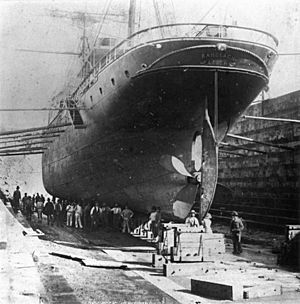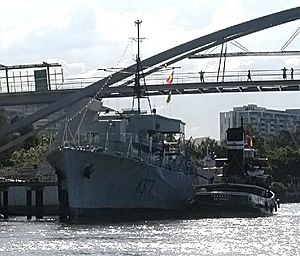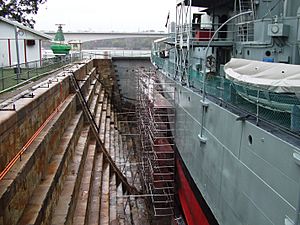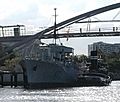South Brisbane Dry Dock facts for kids
Quick facts for kids South Brisbane Dry Dock |
|
|---|---|
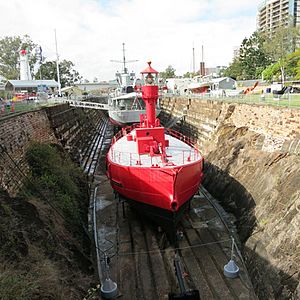
South Brisbane Dry Dock, 2016
|
|
| Location | 412 Stanley Street, South Brisbane, City of Brisbane, Queensland, Australia |
| Design period | 1870s - 1890s (late 19th century) |
| Built | 1876 - 1887 |
| Architect | William David Nisbet |
| Official name: South Brisbane Dry Dock, Government Graving Dock, Queensland Maritime Museum | |
| Type | state heritage (built, landscape) |
| Designated | 21 October 1992 |
| Reference no. | 600301 |
| Significant period | 1876-1973 (historical) |
| Significant components | crane / gantry, pump house, dry dock, shed/s, machinery/plant/equipment - maritime/marine industry, caisson, objects (movable) - marine/maritime industry |
| Lua error in Module:Location_map at line 420: attempt to index field 'wikibase' (a nil value). | |
The South Brisbane Dry Dock is a special old place in South Brisbane, Australia. It's a "dry dock," which is like a giant bathtub for ships! Ships sail in, the water is pumped out, and then people can work on the ship's bottom.
This dry dock was designed by William David Nisbet and built between 1876 and 1887. It's also known as the Government Graving Dock. It's so important that it was added to the Queensland Heritage Register in 1992. It is one of the oldest dry docks in Australia.
Contents
History of the Dry Dock
The South Brisbane Dry Dock was planned in 1875 by William David Nisbet. He was the chief engineer for Harbours & Rivers. The dock was built by a company called J & A Overend from 1876 to 1881.
The Brisbane River was a very busy port back then. Ships needed a place to be fixed and looked after. This dry dock was built to help repair commercial ships and government boats like dredges (boats that clear riverbeds) and barges (flat-bottomed boats).
In the first 18 months, workers dug out the land for the dock. They used the extra dirt to build up streets in South Brisbane. The first ship to use the dock was called the Doon. It sailed in on September 10, 1881.
Over time, more buildings were added. These included a store, a carpenter's shed, a blacksmith shop, and a wharf. By 1887, the dock was made longer, reaching 420 feet (about 128 meters). This was part of the original plan.
For the first 20 years, about 60 ships used the dry dock each year. In 1909, a record 90 ships used it! It made good money for the government until 1925. After that, fewer ships used it because ships were getting much bigger.
During World War II, the dry dock became very busy again. More wharves and facilities were added. Even after the war, it was still used for smaller government and commercial ships.
Eventually, new ways of building ships and larger ships meant the dry dock was not needed as much. Also, the Captain Cook Bridge was built, which made it harder for very tall ships to reach the dock.
The government closed the South Brisbane Dry Dock in 1973. Its equipment was moved, and the land was given to the Land Administration Commission. Today, the Brisbane City Council looks after the site. It is now home to the Queensland Maritime Museum.
A special ship called HMAS Diamantina came to the dry dock in 1980. This ship was a frigate from World War II and was used by the Royal Australian Navy. It became a museum ship at the Queensland Maritime Museum.
In 2006, Diamantina left the dock for the first time in 25 years. This was so repairs could be made to the dock. She returned a few months later. During the big 2010–2011 Queensland floods, the dry dock filled with water. But because the ship was well-maintained, it floated safely with the floodwaters. Volunteers helped adjust its ropes to keep it from hitting the dock. The ship was not damaged at all!
What the Dry Dock Looks Like
The South Brisbane Dry Dock is across from the old South Brisbane Town Hall. It's also near the old railway line and library. Other important places nearby include Cumbooquepa at Somerville House and the Ship Inn.
The first part of the dry dock is shaped like a "U" with steps on the sides. These steps are called "altars." The part added in 1887 has sloping sides.
The dock was first 320 feet (about 97.5 meters) long. It was later made longer to 420 feet (about 128 meters). At the top, it is about 24 meters wide, and at the bottom, it is about 16 meters wide. The whole dock is about 9.75 meters deep.
The bottom of the dock is made of strong materials like concrete and granite. Hardwood blocks, called keel blocks, are placed on the bottom. These blocks support the ship when the water is drained.
The sides of the dock were built to be very strong and waterproof. They used a mix of clay and concrete, along with stone steps.
The special gate that closes the dock, called a "caisson," was made by a local company called RR Smellie & Co.. It's one of the biggest metal structures made in Queensland at that time.
To the east of the dock is a brick building called the pump house. It has a rounded roof and a tall brick chimney. Inside, there were large pumps that emptied the water from the dock. These pumps were powered by steam engines. New boilers were put in in 1907. Later, in 1924, electric motors replaced the steam engines. Today, the old boilers and pumps are still there, but they don't work anymore.
Next to the pump house was a coal store and a blacksmith shed. The Queensland Maritime Museum Association has built a copy of the original shed.
On the western side of the dock, there were other timber and metal buildings. One of these was the dock master's office, which had two floors. Over the years, many workshops and wharves were built and taken down as needed.
A large crane, which can lift 15 tons (about 13.5 tonnes), is still at the head of the dock. It was built by Ransomes & Rapier. The railway tracks that brought coal to the dock have been removed. The area is now shaded by eucalypt trees.
The dry dock area is now part of the Queensland Maritime Museum. This museum has many old items, including the HMAS Diamantina ship, which sits in the dock.
Why the Dry Dock is Important
The South Brisbane Dry Dock is a very important historical site. It shows us how busy shipping was in Brisbane in the 1800s. It also reminds us of the big industries that used to be along the river.
It's rare to find such an old and complete dry dock in Australia from the 1800s. It teaches us about the engineering and technology used back then.
The dock is also a great example of the work of engineer William D Nisbet. He designed many important structures in Queensland.
The dry dock looks impressive and helps make South Brisbane a special place. It's part of a historic area that includes other old buildings and parks.
Finally, the dry dock is important because of the companies that built parts of it, like J & A Overend and RR Smellie & Co. These companies helped Queensland grow in the 1800s.
Engineering Heritage Award
The South Brisbane Dry Dock has received an award from Engineers Australia. This award recognizes it as an important part of Australia's engineering history.
Images for kids


